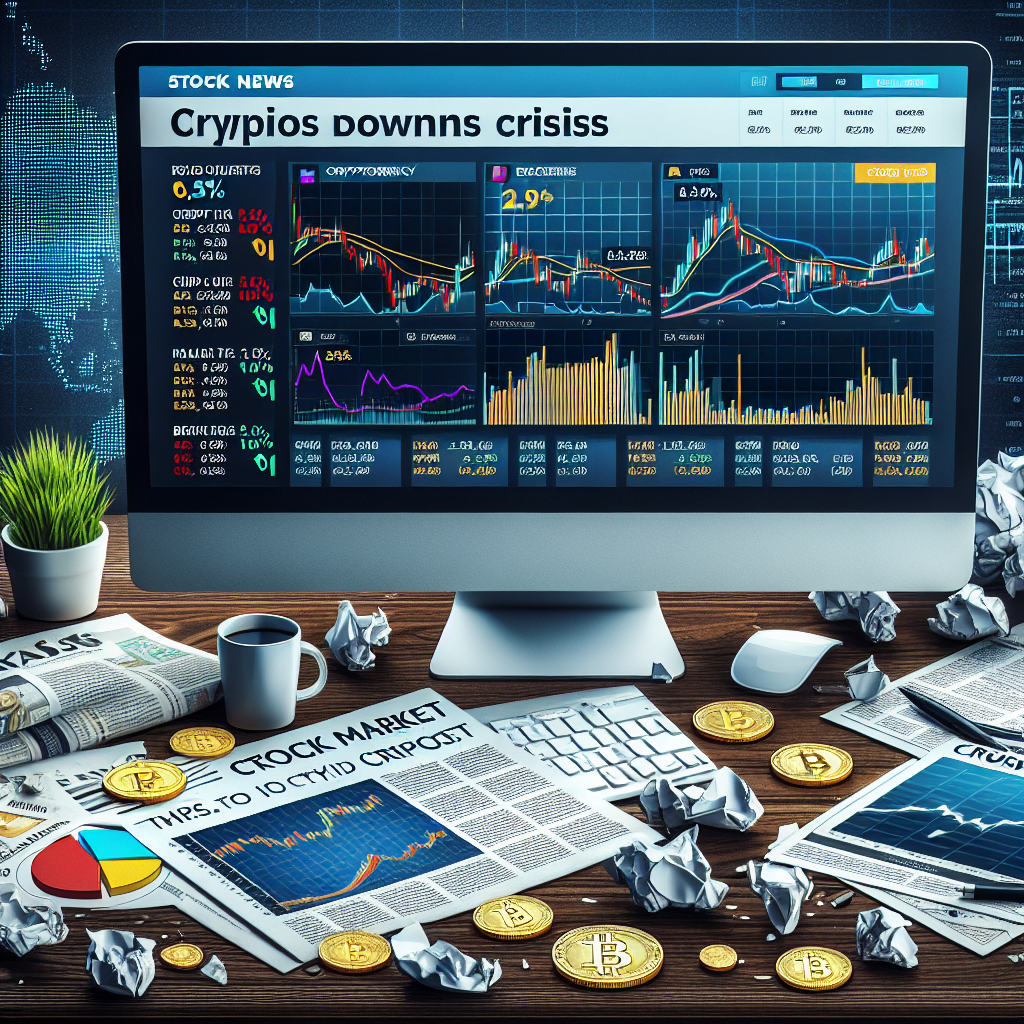“why crypto market is down”
Introduction
Have you ever logged into your crypto wallet or checked the market, only to find the numbers in the red, leaving you wondering why the crypto market is down? You’re not alone. The cryptocurrency market can be as unpredictable as it is fascinating. With its soaring highs and sudden lows, it can turn into a roller coaster ride for investors, both seasoned and newbies. Understanding the factors that lead to these downturns can help you navigate the crypto world with more confidence and insight. Whether it’s Bitcoin, Ethereum, or smaller altcoins, various elements can influence their market performance. Let’s delve into the reasons behind the crypto market’s fluctuations and explore how external factors and market dynamics play a crucial role. This understanding might not only ease your mind during downturns but also equip you with the knowledge to make decisions.
Table of Contents
Factors contributing to the crypto market downturn
The crypto market’s recent downturn can be attributed to an intricate blend of factors, significantly influencing both novice and seasoned investors. Understanding these causes can provide valuable insights and guide better decisions for stakeholders.

Impact of panic selling on the cryptocurrency market
Panic selling plays a substantial role in the crypto market’s volatility. It often starts with a slight dip in market prices, prompting fear among investors. Fear, being contagious, spreads, leading to more investors selling their holdings to avoid further losses. This mass selling results in a sharp decline in cryptocurrency prices. Unlike traditional markets, the crypto market operates 24/7, making it more susceptible to rapid shifts triggered by panic selling. Moreover, the relative novelty and lesser regulation of the crypto market can amplify these shifts, causing dramatic fluctuations in market cap and value.
Influence of the Federal Reserve’s decisions on the crypto market
The decisions of the Federal Reserve, particularly regarding monetary policy and interest rates, wield a significant influence on the crypto market. When the Federal Open Market Committee announces measures such as raising interest rates, it indirectly affects investor sentiment and the crypto market. Higher interest rates typically strengthen the dollar, making traditional investments more attractive compared to risky assets like cryptocurrencies. Consequently, investors may shift their funds from crypto to safer assets, leading to a decline in crypto prices. Additionally, the Federal Reserve’s policies on inflation and monetary tightening can dampen speculative investments, influencing both the short-term and long-term outlook of the crypto market.
Role of short-term traders in the current market situation
Short-term traders, often guided by speculative goals, contribute to the crypto market’s volatility. These traders closely monitor market trends and fluctuating prices, aiming to profit from short-term movements. Although they can inject liquidity into the market, their actions can also lead to abrupt price changes. For instance, a collective move by short-term traders to sell off their holdings in response to minor news or market signals can precipitate a rapid decrease in market value. Furthermore, their speculative trading practices can magnify the effects of other factors, such as panic selling and regulatory news, exacerbating the market’s downturn.
Comparison of traditional markets to the crypto market
Comparing traditional markets to the crypto market reveals distinct dynamics, particularly in how each reacts to economic changes, regulatory updates, and investor sentiments.
Potential effects of a crypto market downturn on gold
Traditionally, gold has been viewed as a ‘safe haven’ during times of economic uncertainty. The potential effects of a crypto market downturn on gold are twofold. Firstly, as investors seek stability, there might be a significant shift towards gold, increasing its price. This is because, unlike cryptocurrencies, gold has a long history of maintaining value over time. Secondly, for some investors, the volatility of the crypto market serves as a reminder of the tangible value and relative stability offered by gold. Therefore, a downturn in the crypto market could reinforce gold’s appeal as a secure investment option, possibly leading to increased demand and price.
Relationship between the collapse of the dollar and cryptocurrency
The relationship between the dollar’s performance and the crypto market is complex. A weakening dollar can lead to an increase in cryptocurrency investment for several reasons. Investors looking to hedge against a devaluing dollar may turn to cryptocurrencies, viewing them as alternative investments outside of the traditional financial system. This can increase demand for Bitcoin, Ethereum, and other leading cryptocurrencies, thereby boosting their prices. Conversely, a strong dollar might detract interest from investing in crypto, as the traditional currency and asset markets may offer more security and less volatility. However, it’s essential to note that cryptocurrencies have their dynamics, influenced by factors beyond the traditional economic indicators affecting fiat currencies. This independence from traditional market forces can sometimes make crypto a more attractive investment during times of dollar instability.
By understanding the multifaceted reasons behind the crypto market’s downturn, including the impact of panic selling, the influence of Federal Reserve policies, and the actions of short-term traders, investors can navigate this volatile landscape more effectively. Additionally, comparing the reactions of the crypto market to traditional markets reveals how external economic factors intertwine with investor behavior, influencing market movements. Whether it’s the potential shift towards gold as a safe haven or the complicated relationship with the performance of the dollar, the crypto market continues to offer both risks and rewards, demanding careful consideration and strategy from anyone looking to invest.
Discussion on the future outlook of the crypto market
The future of the crypto market generates diverse opinions among investors, analysts, and enthusiasts alike. While the market is known for its volatility, understanding its potential trajectory requires a multi-faceted approach, looking at past trends, emerging technologies, and global economic indicators. The ability to predict the market with good accuracy remains a challenge, but certain patterns and indicators can provide valuable insights.
Predictability of the crypto market with good accuracy
Predicting the crypto market with high accuracy is notoriously difficult due to its inherent volatility and susceptibility to external factors such as regulatory news, technological advancements, and shifts in investor sentiment. However, seasoned investors and analysts often use a combination of technical analysis, market sentiment analysis, and macroeconomic indicators to make educated guesses about future movements. While no prediction method is foolproof, staying informed about global economic trends, regulatory changes, and technological innovations in the blockchain space can help investors make more informed decisions. It’s also important to consider the role of major institutional investors and their potential impact on the market.

Analysis of the crypto market trends over the past two years
Over the past two years, the crypto market has experienced a rollercoaster of highs and lows. After reaching an all-time high in late 2017, Bitcoin and other cryptocurrencies saw significant drops in value. This period was marked by intense speculative trading, regulatory scrutiny, and a growing awareness of the technology among the general public. In recent times, we saw a resurgence in interest, partly due to global economic uncertainties and an increased appreciation of cryptocurrencies’ potential as a hedge against traditional financial systems’ weaknesses.
Several key trends have emerged, including:
– The rise of decentralized finance (DeFi) platforms, which have started to challenge traditional financial systems.
– Increased adoption of cryptocurrencies by businesses and consumers alike for transactions and as a store of value.
– Growing interest from institutional investors, which has provided a degree of stability to market valuations.
– Continual development and adoption of blockchain technology, with more practical applications becoming a reality.
These trends suggest a maturing market that is beginning to find its stable footing despite ongoing volatility. Investors are becoming more knowledgeable, and the market is seeing increased participation from both retail and institutional investors.
Speculation on a possible crypto market decline in the upcoming year
Speculating on the future is always a challenging task, especially in a market as unpredictable as cryptocurrency. Several factors could potentially lead to a market decline in the upcoming year, including:
– Tighter regulatory frameworks around the world as governments aim to gain control over the burgeoning crypto space.
– Potential market saturation as more and more cryptocurrencies and blockchain projects enter the space.
– The risk of technological vulnerabilities or significant hacks that could erode trust in cryptocurrencies.
– Economic downturns or increased market volatility in traditional financial markets that could lead to reduced risk appetite among investors.
However, it’s also possible that the crypto market could continue its growth trajectory, especially as it becomes more integrated with traditional financial systems and as new technologies like Ethereum 2.0 promise to solve some of the scalability and security issues that currently plague the market.
The future outlook of the crypto market remains a subject of much speculation. While there are potential risks that could lead to a decline, there are also numerous positive trends that suggest continued growth and maturation of the market. As always, investors should conduct thorough research and consider a wide range of factors before making investment decisions in the crypto space.

Conclusion
Navigating the turbulent waters of the cryptocurrency market can often feel like a roller coaster ride with its rapid ascents and dizzying drops. The factors mentioned above, from panic selling to regulatory shifts and market speculation, all play pivotal roles in the current downturn. However, understanding these dynamics offers a clearer perspective, enabling both seasoned investors and novices to make more informed decisions.
– Stay informed: Regularly update your knowledge about global economic trends and their potential impact on cryptocurrencies.
– Diversify: Don’t put all your eggs in one basket. Distributing investments can lessen the blow during market downturns.
– Long-term perspective: Cryptocurrency is still in its infancy, with much room for growth and innovation. Keeping an eye on the long-term horizon might smooth out short-term market volatility.
Remember, while the descent might be frightening, each downturn has historically presented opportunities for recalibration, learning, and sometimes, unparalleled returns for those who endure. As the market matures, staying informed, diversifying your portfolio, and maintaining a long-term viewpoint could be your best strategies for navigating the crypto space.
Frequently Asked Questions (FAQ) about the Crypto Market
Q: Why is the crypto market down?
A: The crypto market is down due to a combination of regulatory uncertainty, market volatility, and bearish sentiment.
Q: What is regulatory uncertainty?
A: Regulatory uncertainty refers to the lack of clear and consistent regulations governing the use of cryptocurrencies. This can lead to uncertainty and fear among investors, causing them to sell their holdings and drive down the value of cryptocurrencies.
Q: What is market volatility?
A: Market volatility refers to the extreme fluctuations in the price of cryptocurrencies. This can be caused by a variety of factors, including market sentiment, regulatory changes, and technological developments.
Q: What is bearish sentiment?
A: Bearish sentiment refers to a negative outlook on the future performance of the crypto market. This can lead to a decrease in investor confidence and a subsequent drop in the value of cryptocurrencies.
Q: What can be done to improve the crypto market?
A: To improve the crypto market, regulatory clarity and stability are needed, along with increased adoption and mainstream acceptance of cryptocurrencies. Additionally, technological advancements and innovations can help to mitigate market volatility and improve the overall performance of the market.
Q: Is it safe to invest in cryptocurrencies?
A: Investing in cryptocurrencies carries risks, including market volatility, regulatory uncertainty, and the potential for fraud or scams. It is important to do your own research and consult with financial professionals before making any investment decisions.
Q: What are the most popular cryptocurrencies?
A: Some of the most popular cryptocurrencies include Bitcoin, Ethereum, and Binance Coin. These cryptocurrencies have a large market capitalization and are widely used for various purposes, such as payments, trading, and investment.
Q: How do I buy cryptocurrencies?
A: To buy cryptocurrencies, you will need to use a cryptocurrency exchange or brokerage platform. You will need to create an account, verify your identity, and link a payment method, such as a bank account or credit card. Once your account is set up, you can place an order to buy the cryptocurrency of your choice.
Q: What is the future of the crypto market?
A: The future of the crypto market is uncertain and depends on a variety of factors, including regulatory clarity, technological advancements, and market sentiment. Some experts believe that cryptocurrencies have the potential to revolutionize the financial industry, while others are more skeptical. It is important to stay informed and make informed decisions based on your own research and risk tolerance.
